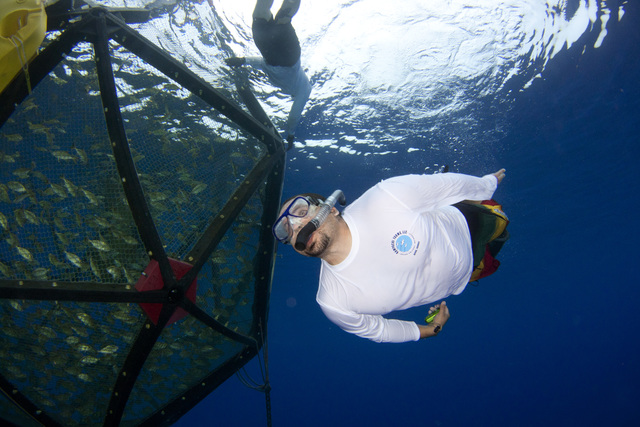KAILUA-KONA — A Kailua-Kona research company plans to launch an experimental off-shore kampachi pen that will hold more than seven times the fish of previous efforts. ADVERTISING KAILUA-KONA — A Kailua-Kona research company plans to launch an experimental off-shore kampachi
KAILUA-KONA — A Kailua-Kona research company plans to launch an experimental off-shore kampachi pen that will hold more than seven times the fish of previous efforts.
Under a permit from the National Marine Fisheries Service which is now up for public comment, Kampachi Farms would deploy a 40-foot wide cylindrical pen stocked with 15,000 fish in federal waters 5.5 miles off of Keauhou. The site, with a pre-existing buoy, hosted the company’s earlier experiments with smaller pens.
“We want to get it to a larger scale so we can make it economically efficient,” said Neil Sims, Kampachi Farms’ co-CEO. “Two thousand fish is a nice research project. Fifteen thousand fish is a more meaningful research project, but we want to be doing 150,000 fish per cage.”
Kampachi Farms, based at the Natural Energy Laboratory of Hawaii Authority, has set its sights on federal waters due to the competition for nearshore space, Sims said.
“We need to scale it up to meet global protein needs,” Sims said. “We can’t do that in nearshore areas. We need to do it over the horizon.”
The defense company Lockheed Martin partnered with Kampachi Farms to develop the technology used in the trial. An offshore aquaculture division of Lockheed has since spun off into a venture called Forever Oceans, which Sims said will be in close collaboration on the Vellela Delta project. The pen could be deployed by May if the permitting is approved.
NMFS officials say the Vellela Delta trial will be well flushed by ocean currents in 6,000 feet of water, and should have minimal impact on water quality. A maximum of two cohorts of fish would be raised over two years, for a total of no more than 30,000 fish or about 120,000 pounds, according to a draft environmental assessment. Kampachi can be harvested every eight months.
A previous project from 2013 to 2014 featured an unmanned 22-foot wide net pen, with feeding, monitoring and security handled remotely from anywhere that had Internet access. Workers had to visit the pen only once a week to top off the food hopper on the feed vessel and fuel a generator, Sims said. A similar test occurred in 2011 to 2012 as the company gradually scaled up its technology.
The latest trial employs a larger pen that is shaped like a cylinder rather than a sphere, and an improved control system.
Each phase required a separate environmental assessment and federal permit, Sims said. Both of the previous projects attracted a large number of ahi, mahimahi, ono and marlin, serving as fish aggregation devises that were a prime destination for fishermen, he said.
The fisheries service is taking comments until Tuesday on the draft EA and its proposal to issue a permit.
Info: https://www.regulations.gov/#!docketDetail;D=NOAA-NMFS-2015-0137



